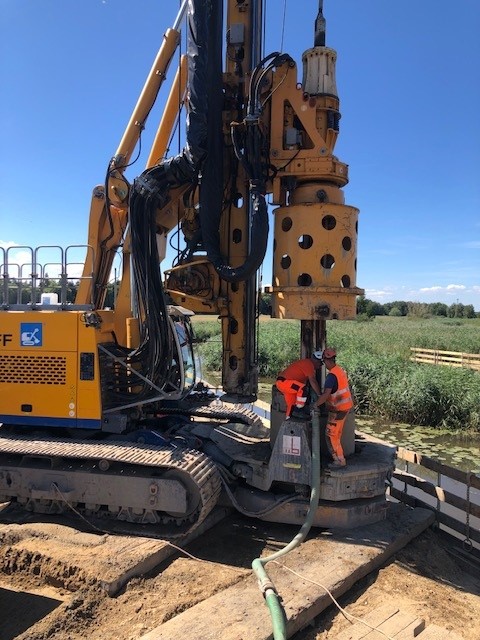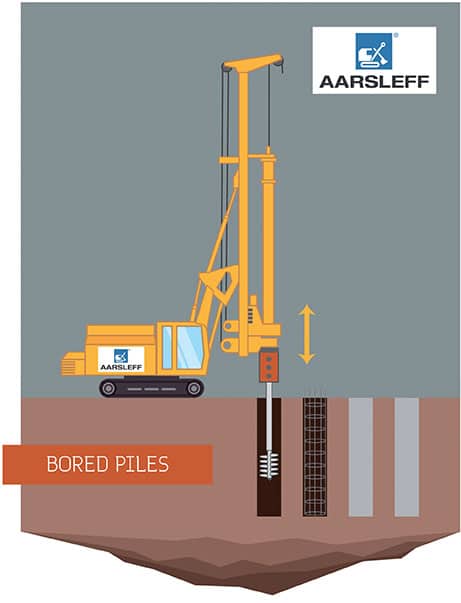Navigating Rotary Bored Piling: Answering Your Top Questions
Ever wondered about rotary bored piling?
As experts in the design and delivery of rotary bored piling operational excellence, we’ve answered five of the top questions surrounding rotary bored piling, shedding light on its nuances, advantages, and drawbacks.
1. What is the difference between rotary bored piling and CFA piling?
Rotary bored piling and Continuous Flight Auger (CFA) piling are both widely used techniques for creating deep foundations, but they differ significantly in their methodology. Both methods involve drilling into the ground to create piles, as opposed to a displacement pile such as driven precast concrete piling. Rotary bored piling uses an auger or drilling bucket to excavate soil, which is then removed from the borehole using a temporary casing or by flushing it out with a drilling fluid. CFA piling uses a continuous helical auger that remains within the borehole, with concrete pumped through the hollow stem as the auger is withdrawn.
The concrete pouring is the key difference. With rotary bored piling the concrete is poured into a prepared borehole which is held open. In CFA piling, the drilling and concrete pouring is a simultaneous operation with the concrete pumped down the auger’s flight as it is extracted from the borehole.

2. How do you install rotary bored piles?
Installing rotary bored piles consists of the following steps:
- Site setup
The rig and equipment is mobilised to site and the piling platform is checked before the rig is driven into position.
- Drilling
Once the rig is in position, the rotary drilling head is attached to the rig’s mast. This is used to bore the pile. Spoil is continuously removed from the borehole, either by using a temporary casing or by flushing with a drilling fluid to hold the borehole open.
- Reinforcement
Once the designed pile depth is reached, either a crane or an excavator is used to lower the reinforcement cages into the borehole.
- Concrete pouring
Concrete is then poured into the borehole, often using a tremie rack system to ensure the flow of the concrete is sufficient and suspension is maintained as it is poured. This displaces the drilling fluid or casing and once set, if used the casing is extracted.

3. What different construction methods are used for rotary bored piling?
Rotary bored piling is a highly flexible method of piling with many adaptations available for ground conditions and any specific project requirements. The ability to use either temporary casing or a drilling fluid means that ground conditions can be accounted for and a variety of ancillary drilling equipment can be deployed if needed. This flexibility means that a custom installation methodology can be utilised for each site, ensuring optimal outcomes in diverse geological settings.
4. What are the advantages of rotary bored piling?
Rotary bored piling has several advantages that could make it an optimal solution for your site.
It’s incredibly versatile which means it can be used in a huge range of ground conditions, including cohesive soils, granular materials, and rock formations.
Its versatility includes greater depth and diameter capabilities when compared with CFA and any precast solution. This means it is suitable for projects which need substantial load-bearing, and the way reinforcement is added allows for a vast variety of options to be added, compounding that load-bearing capacity.
These combined mean that rotary bored piling is often the solution used when nothing else is possible. Its ability to carry extremely large loads and adapt to ground conditions whilst offering superior integrity and durability, minimises the risk of structural defects and ensures long-term stability.

5. What are the disadvantages of rotary bored piling?
Rotary bored piling is not without its drawbacks. Whilst its versatility and adaptability mean that it is suitable for almost any piling site, this comes with an associated cost. Equipment and expertise needed can result in higher initial costs when compared with alternative methodology like CFA piling and therefore can make it a less economical option.
The other economic disadvantage is it is a slower process than CFA or driven alternatives. Due to the technical nature of the work, the piles take longer to install and therefore, projects can have longer programmes.
Another notable disadvantage is the potential for groundwater contamination during drilling operations, especially in permeable ground conditions where drilling fluid may seep into surrounding aquifers. This can be handled by close observation and skilled workforce, or by using temporary casing.
Finally, the technique may encounter limitations in restricted access sites or areas with overhead obstructions, necessitating careful planning and coordination to overcome logistical challenges.
In conclusion, rotary bored piling stands as a cornerstone of modern foundation engineering, offering unparalleled versatility, reliability, and performance. At Aarsleff Ground Engineering, we take pride in our expertise in this technique, leveraging our experience and innovation to deliver operational excellence for our clients.
Get in touch below to speak about your project and how we can assist in achieving your goals
The Latest. News, podcasts & projects
Join our mailing list






